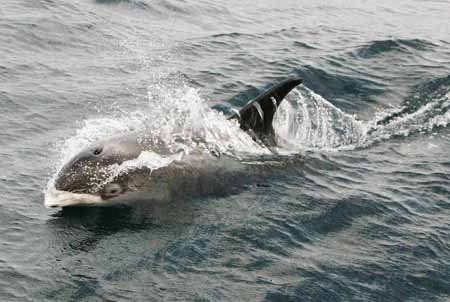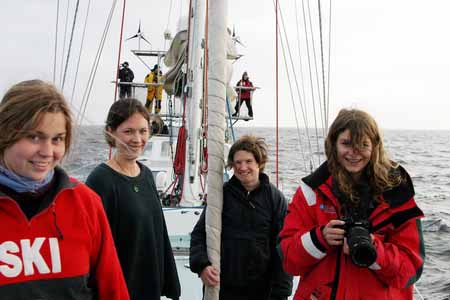As we begin the long track from the west side of the large Dogger Bank survey block, seals dominate the morning’s sightings. A single harbour porpoise is spotted from the A-frame but by early afternoon, the excitement had died down and the rest of the day passes with no further sightings. The following day however is nicknamed International Day of the white-beaked dolphin! White-beaked dolphins bow-riding from early morning into the night. Strikingly large and robust, white-beaked dolphins are capable of swimming at considerable speed, and the body pattern of white, grey and black is highly variable between individuals. The dolphin groups range in size from 4 to 8 animals including a mother and calf and one juvenile. Amazing buzzes and whistles are heard on the hydrophone as the largest group of adult dolphins jostle for pole position on the bow. Throughout the day large groups of hundreds of seabirds are seen sitting on the water and swirling around in the air –the North Sea really feels alive.

Sightings and detections of harbour porpoises continue intermittently throughout the western survey block, interspersed with several loud mechanical gas rig noises and dolphin whistles. As we cross to the east of the large block we enter Danish waters, which are crowded with gas platforms, especially along the boundary between Danish and German jurisdiction. The weather worsens as we reach the north of the eastern block and the observers abandon the A-frame in favour of the slightly more stable deck. Later in the evening the international jet setting team pass into German waters but there is no improvement in the weather. Marine mammal sightings remain few and far between but we spot a small bird of prey thought to be a female juvenile sparrow hawk. What she is doing in the middle of the North Sea, remains a mystery!
The poor weather remains for the next day or so with the occasional sighting of harbour porpoises, however the storms pass on the second evening and we are able to admire the stunning starscape, complete with the Milky Way and lots of shooting stars. As we finish the south bound transect in Dutch waters and start to make our way back up the reciprocal route, blue skies and light winds return. It is hard to believe it is November in the North Sea. Unfortunately, even with the excellent observation conditions, our sighting rate does not increase and the whole Eastern transect of the large Dogger Bank block has fewer sightings of marine mammals than the west.

Sorry, comments are closed for this post.